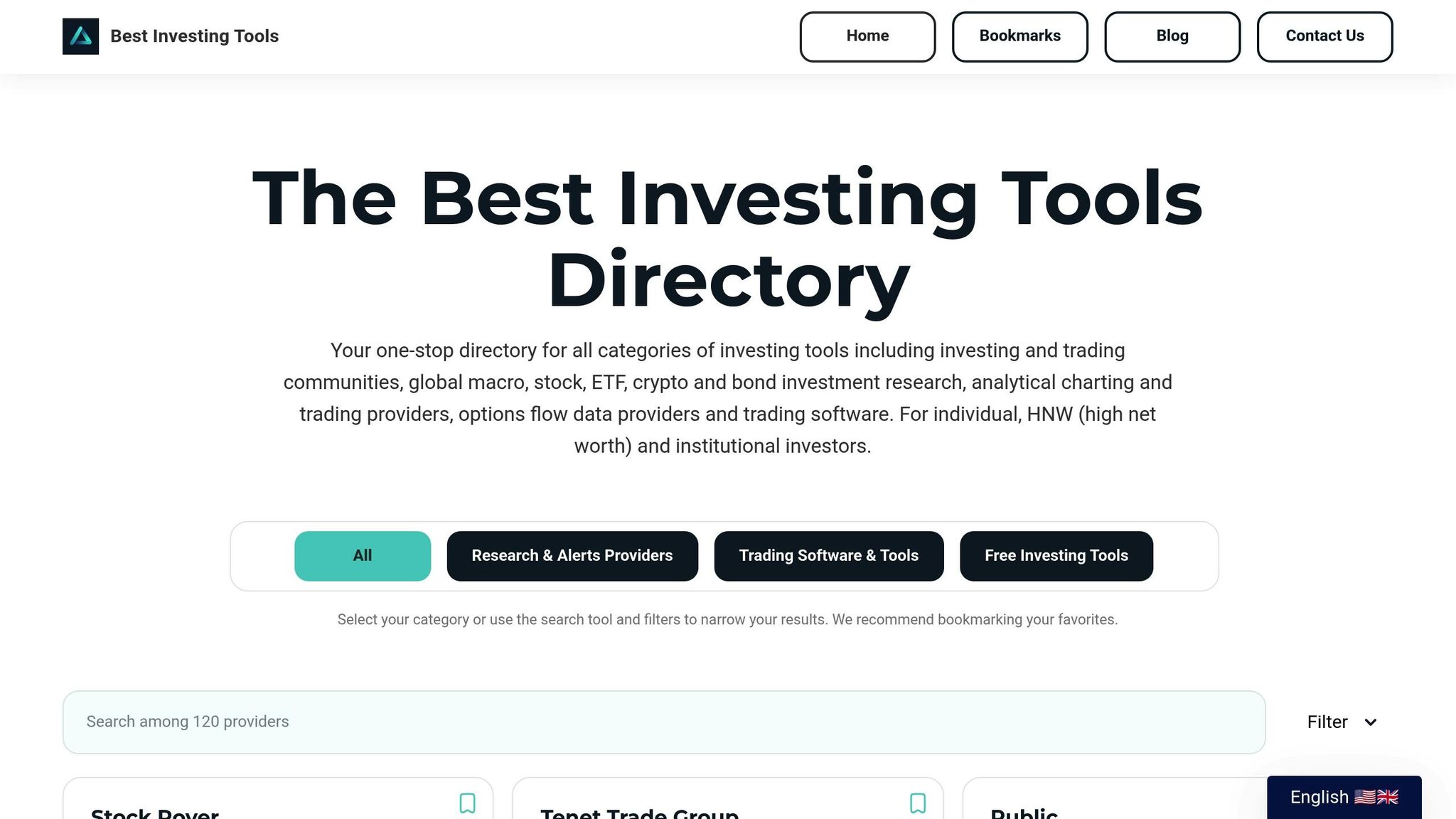Stock market newsletters simplify investing by offering curated stock picks, market analysis, and actionable strategies. They save time, provide expert insights, and help investors make informed decisions. From daily market commentary to sector-specific advice, newsletters cater to diverse strategies like growth investing or value investing. However, costs, biases, and inconsistent performance can be drawbacks. To choose the right one, evaluate track records, expertise, and alignment with your goals. Always balance newsletter advice with your own research for better results.
Best Stock Newsletters of 2025
Types of Stock Market Newsletters
Stock market newsletters come in various formats, each designed to align with specific investment goals and preferences. Understanding these formats can help you choose the one that fits your strategy and needs.
Stock Picks and Recommendations
These newsletters focus on providing specific stock recommendations, often accompanied by clear buy, sell, or hold signals. They may also include entry and exit strategies and model portfolios to help you track performance. Typically, they combine fundamental analysis and technical indicators to justify their selections.
This type of newsletter is perfect for investors looking for actionable investment ideas rather than broad market commentary. It’s especially helpful for busy individuals who don’t have the time to research individual stocks but still want to actively manage their portfolios.
Market Analysis and Commentary
Market analysis newsletters take a broader view, focusing on trends and economic conditions that influence the stock market. They delve into topics like Federal Reserve policies, economic indicators, sector movements, and global market developments.
For example, Morning Brew offers daily updates in a conversational tone, making complex market dynamics easier to digest. These newsletters aim to explain the "why" behind market shifts, helping readers make informed decisions.
This format often includes macroeconomic insights, covering topics like inflation, interest rates, and geopolitical events. It’s a great choice for investors who prefer to make their own stock picks but value professional insights into market timing and overall conditions.
Sector-Specific Newsletters
These newsletters zero in on particular industries or investment themes, offering detailed expertise on niche markets. For instance, a technology-focused newsletter might discuss semiconductor trends, software earnings, or cutting-edge innovations. A healthcare newsletter could analyze pharmaceutical pipelines, biotech breakthroughs, or medical device approvals.
What sets these newsletters apart is their deep industry knowledge. They’re often authored by experts who understand the specific metrics, regulatory landscapes, and competitive factors unique to each sector. Some even emphasize value investing by analyzing financial ratios and balance sheets.
Sector-specific newsletters are ideal for investors who want to specialize in certain industries or develop a deeper understanding of specific market segments. Even diversified investors can benefit from the focused insights these publications provide, using them to fine-tune their broader investment strategies.
Pros and Cons of Stock Market Newsletters
Stock market newsletters offer a mix of advantages and challenges. Weighing these factors can help you decide if they align with your investment strategy.
Main Benefits
One of the biggest perks is access to professional expertise. Many newsletters are crafted by experienced financial analysts who break down complex market data and trends - especially helpful for beginners navigating the stock market.
Another key advantage is time savings. Instead of spending hours sifting through financial reports and news, you get curated insights delivered straight to your inbox.
Newsletters also offer educational value. High-quality ones often share their reasoning, explain valuation techniques, and provide market context, helping subscribers sharpen their own analytical skills over time.
They also expose you to diversified perspectives, introducing you to investment opportunities you might not have considered. This can help broaden your portfolio and avoid the narrow focus that sometimes plagues individual investors.
Some newsletters include performance tracking tools, such as model portfolios or clear buy-and-sell recommendations. These features make it easier to evaluate strategies and learn from both successes and missteps.
However, these benefits come with a few notable downsides.
Common Drawbacks
One major issue is inconsistent performance. Even the most respected newsletters can go through periods of underperformance. Strategies that thrive in one market environment may falter in another, and past results are never a guarantee of future success.
Potential bias is another concern. Some newsletters may have undisclosed relationships with companies they recommend or could be influenced by their own holdings or market narratives. This can lead to advice that serves the publisher’s interests more than yours.
If you subscribe to multiple newsletters, information overload can quickly become a problem. The constant flow of updates, recommendations, and market commentary can make it hard to stick to a clear investment strategy.
Then there’s the issue of cost. Premium newsletters can charge anywhere from a few hundred to several thousand dollars annually. On top of that, following frequent trading advice can rack up significant transaction fees.
Timing issues also present challenges. By the time you read a recommendation and act on it, market conditions may have shifted. Popular newsletters can even cause crowding effects, where a rush of subscribers buying the same stock drives up prices before you can act.
Finally, there’s the lack of personalization. Recommendations are often broad and may not suit your specific financial goals, risk tolerance, or investment timeline. For example, a stock pick tailored for a retiree may not align with the needs of a younger, growth-focused investor.
Side-by-Side Comparison
Here’s a quick look at the pros and cons:
| Advantages | Drawbacks |
|---|---|
| Expert insights from seasoned analysts | Performance can vary over time |
| Saves time on research | Risk of biased recommendations |
| Helps build investing knowledge | Too much information can overwhelm |
| Broadens your investment horizons | High subscription costs |
| Clear performance tracking tools | Delays in acting on recommendations |
| Introduces new sectors and trends | Advice may not fit your personal needs |
| Curated, actionable insights | Trading fees from frequent activity |
| Provides market context | Crowding effects from popular picks |
To get the most out of stock market newsletters, balance their insights with your own research and always keep your personal financial goals in mind.
How to Choose the Right Stock Market Newsletter
Picking the right stock market newsletter can feel overwhelming, especially with so many options out there. But by focusing on a few key factors, you can avoid costly mistakes and find a service that fits your investment needs.
What to Look For
Start with track record and transparency. Look for newsletters that provide clear, detailed performance histories, including specific dates, entry/exit points, and a breakdown of both wins and losses. Be cautious of services that only highlight their successes or make vague claims about their performance.
Next, consider the editorial expertise behind the newsletter. Are the authors experienced in finance or the specific sectors they cover? Reputable services will include detailed bios of their team members, showcasing their education, professional background, and investment philosophy.
Make sure the investment approach aligns with your own goals. Whether the focus is on value investing, growth stocks, or specific industries like tech or healthcare, the newsletter’s strategy should match your risk tolerance and investment timeline.
The frequency and format of the newsletter should also suit your schedule. Some investors prefer daily updates, while others might favor in-depth weekly or monthly analyses. Think about how much time you can realistically commit to consuming and acting on the information.
Pay close attention to the cost structure. Subscriptions can range from $200 to $5,000 annually, so weigh the price against the potential value of their recommendations. If the newsletter suggests frequent trades, don’t forget to factor in trading fees as well.
Finally, look for trial periods and guarantees. Many reputable newsletters offer 30- to 90-day trials or money-back guarantees, giving you a chance to evaluate the quality of their advice before making a long-term commitment.
While these factors can help you identify strong options, it’s just as important to watch for warning signs.
Warning Signs to Avoid
Be wary of unrealistic performance claims. Any newsletter promising guaranteed returns or flawless strategies is not being honest. The stock market carries risks, and no approach works 100% of the time.
Avoid services that rely on pressure tactics and urgency. If a newsletter tries to create a sense of scarcity or pushes you to act quickly, it’s often a red flag.
A lack of contact information or poor customer service can indicate unprofessional operations. Legitimate newsletters will provide clear ways to get in touch and should have responsive support teams.
Check for vague or misleading disclaimers. Pay close attention to the fine print, especially regarding how performance metrics are calculated or whether the publishers personally trade their recommendations.
Be cautious of newsletters that focus heavily on penny stocks or other speculative investments. These services often prioritize entertainment over serious, well-researched advice.
Lastly, steer clear of newsletters with no clear investment thesis. Quality services will explain their recommendations in detail, providing data and analysis to back up their claims.
By avoiding these pitfalls, you’ll be in a better position to make informed choices. But even with the best newsletter, your own research is essential.
Do Your Own Research
Think of newsletter recommendations as a starting point, not the final word. It’s crucial to verify their analysis independently before making any investment decisions.
Start by reviewing financial statements and earnings reports for the recommended stocks. Check metrics like revenue growth, profit margins, debt levels, and cash flow to ensure the company’s fundamentals align with the newsletter’s claims.
Cross-check recommendations using multiple sources. Analyst reports, recent news, and technical indicators can provide additional context and help you spot risks or opportunities the newsletter might have overlooked.
Always consider your personal situation. A stock that fits the newsletter’s model portfolio might not align with your risk tolerance, investment timeline, or tax considerations. Think about how the recommendation fits into your overall portfolio strategy.
Before committing real money, test the newsletter’s advice by paper trading for a few months. Track the performance of their recommendations and assess whether their strategy works for your schedule and trading capabilities.
The ultimate goal is to build enough confidence and knowledge to decide which recommendations truly align with your financial goals and risk preferences.
sbb-itb-2e26d5a
How to Use Newsletter Insights Effectively
Once you've identified and evaluated worthwhile newsletters, the next step is figuring out how to incorporate their insights into your investment strategy. Newsletters can be a valuable resource, but they should never take the lead in your decision-making. Think of them as one piece of the puzzle - a tool to enhance your strategy, not define it. Below, we'll cover practical ways to integrate newsletter advice, track outcomes, and manage risks effectively.
Adding Newsletter Data to Your Strategy
Newsletter recommendations are best used to supplement your existing investment approach, not replace it. Start small by dedicating only a limited portion of your portfolio to newsletter-inspired ideas. This cautious approach minimizes risk while allowing you to test the value of their insights.
For every recommendation, establish a clear evaluation process. Does the suggestion align with your risk tolerance? Does it fit within your portfolio's current composition? For instance, if you're already heavily invested in tech, it might make sense to skip additional tech-related picks from a newsletter. Let your portfolio's overall balance guide your decisions.
Another smart tactic is dollar-cost averaging. Instead of investing the full amount a newsletter suggests all at once, spread your purchases over weeks or months. This strategy can help reduce the risks associated with market timing while still leveraging the newsletter's guidance.
Keep meticulous records of the recommendations you act on - and those you don’t. Tracking these decisions will help you refine your evaluation process over time and identify patterns in what works for your portfolio.
Tracking Performance Results
To truly understand the impact of newsletter recommendations, establish a tracking system. Record key details like entry and exit points, timing adjustments, and risk-adjusted returns (using metrics like the Sharpe ratio) compared to relevant benchmarks. Often, your real-world results will differ from the theoretical performance outlined in the newsletter due to factors like timing or holding periods.
Pay attention to more than just raw gains and losses. For example, a newsletter that boasts 15% annual returns but comes with wild price swings might not be as appealing as one delivering steady, moderate growth. Risk-adjusted metrics can help you determine whether a newsletter's strategy aligns with your comfort level.
Regularly review your portfolio - quarterly or semi-annually is a good cadence. Assess both individual investments and the overall impact of newsletter-inspired picks. Ask yourself: Does the original investment thesis still hold? Are the reasons you followed a particular recommendation still valid?
Document lessons from both your successes and failures. Understanding why certain picks performed well while others fell short can sharpen your ability to evaluate future advice. Over time, this process will help you make more informed and selective investment decisions.
Diversification and Risk Management
While newsletters can offer intriguing ideas, managing risk is just as important as tracking performance. Avoid putting too many eggs in one basket by diversifying newsletter-inspired investments across different sectors, market caps, and investment styles. For example, if a newsletter focuses on small-cap growth stocks, balance that with ideas from large-cap or dividend-paying companies.
Tailor position sizes to match your risk tolerance and portfolio goals. A recommendation to allocate a fixed percentage of your portfolio to a speculative stock might work for one investor but not for someone with a more conservative approach.
Set your own stop-loss levels and profit-taking targets - independent of the newsletter's guidance. While some newsletters may suggest holding onto a stock indefinitely, your personal risk management rules should always take precedence. Clear exit criteria can help protect your portfolio from unnecessary losses.
Also, keep an eye on correlations between newsletter picks. Too much overlap in sectors or styles can increase concentration risk, even if the individual recommendations seem diverse.
Remember, newsletters rarely outperform benchmarks when risk is factored in. This highlights the importance of treating their insights as a starting point for your research - not a shortcut to guaranteed success.
Ultimately, your core investment strategy should remain the foundation of your financial plan. Use newsletters to uncover opportunities, but don’t let their performance dictate your long-term goals. Even the most impressive track records can’t replace the importance of a well-rounded, disciplined approach.
Using the Best Investing Tools Directory

Finding the right stock market newsletter can feel overwhelming with so many options to sift through. That’s where the Best Investing Tools Directory comes in. It’s a one-stop platform designed to help you research and compare investment tools, including newsletters. By combining this resource with the strategies outlined earlier, you can ensure that each newsletter you consider aligns with your specific goals and preferences.
About the Best Investing Tools Directory
The Best Investing Tools Directory is more than just a list - it’s a thoughtfully curated resource aimed at helping investors make smarter decisions. It features detailed reviews of a wide range of tools, including investment research platforms, newsletters, online trading software, charting tools, options data, and technical analysis resources.
What makes this directory stand out is its ability to consolidate reviews and compare features across services. Whether you’re a beginner figuring out where to start or a seasoned investor looking for advanced insights, the directory’s filters allow you to zero in on tools that match your expertise and investment style.
How to Navigate the Directory
Once you’re familiar with what the directory offers, it’s time to dive in. Start by using the filtering options to narrow your focus to stock market newsletters. From there, refine your search based on criteria like investment approach or target audience.
When comparing newsletters, pay attention to key details like their track record, the qualifications of their authors, and the type of analysis they provide. The directory also helps flag potential concerns, such as vague methodologies or overly optimistic performance claims.
To make the most of the directory, create a shortlist of newsletters that meet your criteria. Instead of subscribing right away, take time to evaluate each option by comparing features like how often updates are published and the depth of the analysis provided. This systematic approach can save you time and ensure you choose a newsletter that truly meets your needs.
Resources for Different Types of Investors
The directory is designed to cater to a wide range of investors. For individual investors, it offers listings tailored to various experience levels. Beginners can find straightforward resources, while experienced investors can explore advanced strategies and sector-specific insights.
If you’re managing a larger portfolio or working at an institutional level, the directory highlights tools with more in-depth research and robust analytics. It’s easy to distinguish between services aimed at retail investors and those built for professional-grade portfolio management.
For those with niche interests, the directory’s filters allow you to find tools that align with your unique investment philosophy or specific portfolio goals. Whether you’re focused on growth stocks, value investing, or another strategy, the platform helps you identify resources that support your approach.
Conclusion
Stock market newsletters have come a long way, transforming from printed pamphlets into digital resources that can sharpen your investment strategies. In this guide, we’ve looked at how these newsletters provide everything from targeted stock recommendations to in-depth market analysis, making them a valuable tool for navigating today’s intricate financial world.
When it comes to choosing the right newsletter, it’s all about aligning it with your investment goals. Whether you’re after sector-specific advice, technical breakdowns, or fundamental research, the right newsletter can offer insights that enhance your own analysis. However, it’s important to use newsletters as part of a broader information strategy rather than relying on them exclusively for decision-making.
To get the most out of these resources, track how their recommendations align with your portfolio objectives. This approach allows you to determine which subscriptions are genuinely helpful and which ones might not be worth keeping.
If you’re unsure where to start, the Best Investing Tools Directory is a time-saving resource that provides detailed reviews of various investment tools. Instead of experimenting with multiple newsletters, the directory’s filtering options and thorough evaluations can help you pinpoint the services that best suit your needs and experience level.
FAQs
How do I determine if a stock market newsletter is trustworthy and worth subscribing to?
When assessing the reliability and usefulness of a stock market newsletter, start by digging into its track record. A solid newsletter will showcase a consistent history of accurate stock picks and provide transparent performance data. Pay attention to whether it openly explains its investment approach - whether that's through quantitative analysis, tracking market trends, or leveraging expert opinions.
It's also important to see if the newsletter shares its methodology and offers regular updates on past stock recommendations. Be cautious of services that lack openness, make exaggerated promises, or show inconsistent results. Taking the time to evaluate these aspects can guide you toward a smarter subscription choice.
How can I avoid common mistakes like biased advice and information overload when using stock market newsletters?
To avoid biased advice in stock market newsletters, stick to sources that emphasize transparency and rely on facts rather than flashy promotions. Seek out newsletters with a solid track record, and be cautious of those with potential conflicts of interest or a heavy dependence on paid endorsements.
When dealing with information overload, focus on newsletters that closely match your investment objectives. Eliminate unnecessary or repetitive content to streamline your reading. Tools that organize and highlight key insights can help you zero in on actionable information without feeling buried under excess data. Staying focused and keeping a long-term approach in mind can further guide you in making sound decisions, rather than reacting impulsively to short-term market noise.
How can I use stock market newsletters to enhance my investment strategy without becoming overly dependent on them?
Stock market newsletters can be a helpful tool for sparking ideas and gaining insights, but they should serve as a supplement to your own research - not a substitute. To make the most of these newsletters, compare their recommendations against broader market trends, dive into company financials, and consider how they align with your personal investment goals. This extra step ensures the advice fits within your overall strategy.
By viewing newsletters as just one piece of the puzzle, you can benefit from expert opinions while still relying on your own judgment. This balanced approach minimizes overdependence on any single source and helps you make more informed and confident investment choices.



